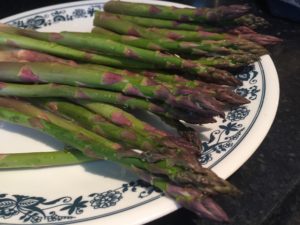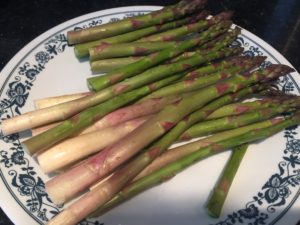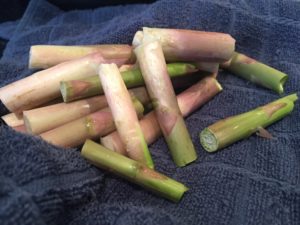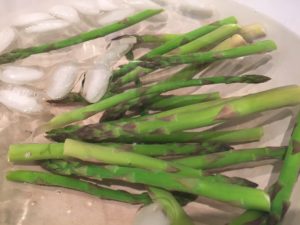» Jump to recipes using Asparagus as an ingredientAsparagus-
Asparagus is a perennial, spring vegetable. It grows in spears.
The stems of the asparagus will naturally snap to remove the woody bottoms. Asparagus can be grilled, roasted, steamed, blanched etc. Some people like to peel the outer layers of their asparagus, but it is not necessary. Be careful not to overcook, they will become stringy and/or mushy.
Green- the most common variety
White- a field blanched version on the green variety
Purple- very tender and sweet, but loses its purple color when cooked
When you get your asparagus home, cut the bottoms just a tiny bit (1/4 to 1/2 inch) before placing upright in a glass of water, just covering the base of the stalks with about 1/2 inch or so. Treat them like a flower, keeping them on the countertop for up to a few days.
Vitamin C, A, K, thiamin, folate, iron, fiber

There’s nothing quite like fresh asparagus in the springtime. Aside from some tunnel spinach, it’s essentially the first crop that wakes up from the winter doldrums and makes you realize that the Summer CSA is just around the corner. The crunch, the taste, the fact that it’s packed with vitamins and nutrients, what’s there not to like?
Fresh asparagus from the farm is a real treat, as you can just munch on and enjoy it raw as it’s so tender and sweet.
 When prepping your stalks for consumption you’ll want to “trim” the ends. I find the best way to do this is just to bend the bottom part of the stalk until it snaps.
When prepping your stalks for consumption you’ll want to “trim” the ends. I find the best way to do this is just to bend the bottom part of the stalk until it snaps.
 Wherever the snap of the natural breaking point occurs, is where the tough fibrous end begins.
Wherever the snap of the natural breaking point occurs, is where the tough fibrous end begins.

Save the snapped off woody stems for an amazing stock.

When I have asparagus around, I usually can’t help but drape a runny-yolked egg on top. Roasting them at 400 with a little drizzle of olive oil, a favorite method of consumption. Another classic preparation is blanching your asparagus. Take a few spears of the fresh asparagus and put them into already boiling water, just for a short period of time (1 minute or so) and then quickly transferring them into a bowl with ice and cold water.  This process, called blanching, both locks in the flavor and crispness as well as preserves the vibrant green color.
This process, called blanching, both locks in the flavor and crispness as well as preserves the vibrant green color.

Recipes Using Asparagus
Grab a ball of pizza dough and get ready for deliciousness! This pizza skips the tomato sauce and with the freshly ground sausage, mozzarella and spring veggies, you won’t miss it! When the dark green of the spring veggies is in your kitchen, you need to try this one!
Burrata is a great centerpiece appetizer It’s unusual texture just screams “spread me on a crispy baguette please”. Toss roasted veggies of your choice on top with some freshly ground black pepper or finely chopped fresh herbs of your choice, and WOW!
Prepare a pie crust, fill it with springtime goodness, and you’re off to the races with this flexible recipe. Mozzarella House cheeses go great with the springtime veggies in this dish, not to mention the cheese and garlic sausage.







 This process, called blanching, both locks in the flavor and crispness as well as preserves the vibrant green color.
This process, called blanching, both locks in the flavor and crispness as well as preserves the vibrant green color.


